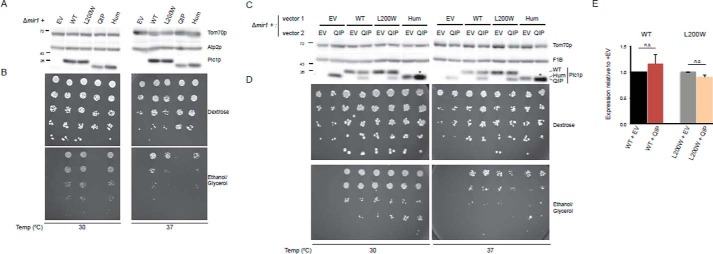FIGURE 1.
Modeling the novel compound heterozygous mutation in human PiC using yeast. A, steady-state protein expression and growth analyses of PiC variants and humanized PiC in comparison with WT. Immunoblotting for Pic1p and the loading controls Tom70p and Atp2p was done using yeast whole cell extracts. B, 1:4 dilutions of the same set of strains were tested for functional growth using the indicated media. Plates were incubated at 30 or 37 °C for 3 days except for YPEG at 37 °C, which was cultured for 10 days. C, steady-state protein expression and growth analyses of WT PIC, PICL200W variant, and PICHum in the presence or absence of co-expressed PICQIP as in A. D, 1:4 dilutions of the same set of strains were tested for functional growth using the indicated media at the designated temperature. Plates were incubated for 3 days (YPD at 30 °C), 5 days (YPD at 37 °C and YPEG at 30 °C), or 13 days (YPEG at 37 °C). E, quantification of PIC or PICL200W protein amounts at 37 °C in the presence or absence of PICQIP (n = 9). Data are presented as means; error bars represent S.E. n.s., differences not significant. EV, empty vector; YPD, 1% yeast extract, 2% peptone, 2% dextrose; YPEG, 1% yeast extract, 2% peptone, 1% ethanol, 3% glycerol.

